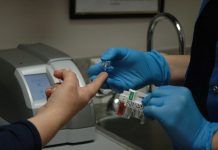New research reveals that insulin applied in therapeutic doses selectively stimulates the formation of new elastic fibers in cultures of human aortic smooth muscle cells. These results advance the understanding of the molecular and cellular mechanisms of diabetic vascular disease. The study is published in the February issue of the American Journal of Pathology.
"Our results particularly endorse the use of insulin therapy for the treatment of atherosclerotic lesions in patients with type I diabetes, in which the induction of new elastic fibers would mechanically stabilize the developing plaques and prevent arterial occlusions," explained lead investigator Aleksander Hinek, MD, PhD, DSc, Professor, Division of Cardiovascular Research, The Hospital for Sick Children and the Department of Laboratory Medicine and Pathobiology, University of Toronto.
Primary insulin deficiency and decreased cellular sensitivity to insulin have been implicated in the pathogenesis of impaired healing processes, atherosclerosis and hypertension, all frequently observed in patients with both type I and type II diabetes.
However, the possibility of a direct contribution of insulin to the cellular and molecular mechanisms that control the production of elastic fibers (elastogenesis) has not been explored. The researchers conducted a series of experiments to determine whether low therapeutic concentrations of insulin would promote the production of elastic fibers in cultures of human aortic smooth muscle cells.
Investigators found that insulin does in fact stimulate the deposition of elastic fibers in cultures of human aortic smooth muscle cells. The data demonstrated, for the first time, that low doses of insulin induce the elastogenic effect solely through the activation of insulin receptor and trigger the downstream activation of the P13K signaling pathway. The ultimate up-regulation of elastic fiber deposition by insulin is executed through two parallel mechanisms: the initiation of elastin gene expression and the enhancement of tropoelastin secretion.
Continue Reading Below ↓↓↓
Importantly, the experimental data suggest that insulin-dependent initiation of the elastin gene transcription occurs after dissociation of the FoxO1 transcription factor from the specific domain identified within the elastin gene promoter. The researchers also demonstrated that insulin may facilitate the transportation of tropoelastin into the secretory endosomes, where it can associate with S-GAL/EBP, the "chaperone" protein that enhances secretion.
"We believe that our discovery of the elastogenic action of insulin allows for better understanding of the pathologic mechanisms in which the lack of insulin, in diabetes type I, or insulin resistance, in diabetes type II, contribute to the development of hypertension and the rapid progression of atherosclerosis," concluded Dr. Hinek.
Dr. Hinek further elaborated on the far-reaching effects these data provide: "Importantly, our newest results indicate that the discovered elastogenic effect of low concentrations (0.5-10 nM) of insulin is not restricted to the arterial smooth muscle cells. Thus, insulin also stimulates formation of elastic fibers by human skin fibroblasts and by myofibroblasts isolated from human hearts.
These observations constitute a real novelty in the field of regenerative medicine and endorse 1) local application of small doses of insulin for ameliorating difficult healing of dermal wounds in diabetic patients and 2) systemic administration of insulin in patients after heart infarctions, in hope that insulin-induced elastic fiber deposition may alleviate formation of maladaptive collagenous scars in the myocardium."
The article is "Insulin Induces Production of New Elastin in Cultures of Human Aortic Smooth Muscle Cells," by J. Shi, A. Wang, S. Sen, Y. Wang, J. Kim, T.J. Mitts, and A. Hinek (DOI: 10.1016/j.ajpath.2011.10.022). It will appear in The American Journal of Pathology, Volume 180, Issue 2 (February 2012) published by Elsevier.
Source: Elsevier Health Sciences










